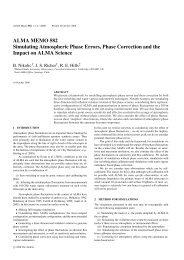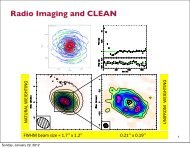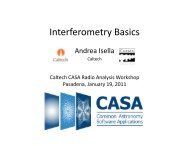A Crash Course in Radio Astronomy and Interferometry: 3 ... - NRAO
A Crash Course in Radio Astronomy and Interferometry: 3 ... - NRAO
A Crash Course in Radio Astronomy and Interferometry: 3 ... - NRAO
You also want an ePaper? Increase the reach of your titles
YUMPU automatically turns print PDFs into web optimized ePapers that Google loves.
Imag<strong>in</strong>g<br />
Weight<strong>in</strong>g <strong>and</strong> Taper<strong>in</strong>g<br />
• Visibility Weight<strong>in</strong>g <strong>in</strong> the FT:<br />
– Includ<strong>in</strong>g weight<strong>in</strong>g function W to modify dirty beam sidelobes:<br />
– natural weight<strong>in</strong>g: density of uv-coverage = highest compact flux<br />
sensitivity<br />
– uniform weight<strong>in</strong>g: extent of uv-coverage = highest resolution<br />
– robust weight<strong>in</strong>g: compromise between natural <strong>and</strong> uniform<br />
– taper<strong>in</strong>g: downweights high spatial frequencies = higher<br />
extended flux sensitivity<br />
• imag<strong>in</strong>g parameters provide a lot of freedom<br />
• appropriate choice depends on science goals<br />
• recall that the primary beam FWHM is the “field-of-view” of a<br />
s<strong>in</strong>gle-po<strong>in</strong>t<strong>in</strong>g <strong>in</strong>terferometric image






